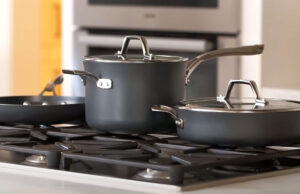As an Amazon Associate, I earn from qualifying purchases at no extra cost to you.
How to Fix Miele Dishwasher F13 Error Code Fast and Easily
Are you frustrated seeing the F13 error code on your Miele dishwasher? Don’t worry, you are not alone! This error usually points to a water supply or drainage problem that can stop your dishwasher from working properly. In this article, we will explore simple ways to fix the F13 error, save your time, and get your dishwasher running smoothly again.
Easy Ways to Solve Miele Dishwasher F13 Error Code
Check the Water Supply
The first thing to do is check your dishwasher’s water supply. Often, the F13 error appears when the dishwasher isn’t getting enough water. Make sure the water tap is fully open and water pressure is normal. Sometimes, the inlet hose can get kinked or blocked, stopping water from reaching the dishwasher.
Next, examine the filter in the water inlet. Dirt or debris can clog it and prevent proper water flow. If it looks dirty, remove it and rinse it under running water. Be careful while cleaning to avoid damaging the filter.
Also, inspect the inlet valve itself. If the valve is faulty, the dishwasher may not fill properly, triggering the F13 error. You may need a professional to replace it if cleaning doesn’t help.
Pay attention to the water temperature. Miele dishwashers need a certain temperature to operate correctly. If the water is too cold or too hot, the appliance may stop working.
- Make sure water tap is fully open
- Check for kinks in the inlet hose
- Clean the inlet filter
- Inspect the inlet valve
- Check water temperature
Inspect and Clean the Drain Pump
A blocked drain pump can also cause the F13 error code. Start by turning off the dishwasher and unplugging it from the power source. Next, remove the lower rack and check the drain pump for any debris or food particles.
Carefully clean the pump area, including any accessible hoses. Sometimes small items like glass pieces or bits of food can block the pump, stopping water from draining. Cleaning it regularly helps prevent the F13 error.
After cleaning, reassemble everything and run a short cycle to see if the error is gone. If the dishwasher still shows F13, the pump might be damaged and may need replacement.
Listen for unusual noises during the cycle. Strange sounds often indicate a blockage or failing pump. Prompt attention can prevent bigger problems later.
- Turn off and unplug dishwasher
- Remove lower rack and check drain pump
- Clean debris and small objects
- Reassemble and test cycle
- Listen for unusual noises
Reset the Dishwasher
Sometimes, the F13 error can be fixed by a simple reset. Start by turning off the dishwasher at the power switch. Wait for a few minutes, then turn it back on. Many minor errors clear themselves after a reset.
If the reset doesn’t work, try a longer power cycle. Unplug the dishwasher for 10–15 minutes and plug it back in. This allows the internal electronics to refresh and can fix minor software glitches.
Be careful not to repeatedly reset the dishwasher if the error persists. Continuous errors may indicate a mechanical or electrical issue that requires professional help.
Always check that the door is fully closed during reset. A partially closed door can prevent the dishwasher from starting and trigger the F13 code.
- Turn off the dishwasher at the power switch
- Wait a few minutes and turn on
- Try unplugging for 10–15 minutes
- Ensure the door is fully closed
- Avoid repeated resets if problem persists
Examine the Water Softener
Miele dishwashers have a water softener system that affects cleaning performance. If it’s not working correctly, it can lead to the F13 error. Check the salt level in the water softener. Low salt can affect water flow and pressure.
Inspect the softener unit for leaks or blockages. Sometimes the softener can get clogged with residue, which prevents proper water circulation. Cleaning or refilling the salt helps fix the problem.
Also, look at the softener settings. Incorrect settings can confuse the dishwasher, leading to error codes. Make sure the settings match your water hardness level.
Regular maintenance of the water softener reduces the risk of recurring F13 errors and improves overall dishwasher performance.
- Check salt level in water softener
- Inspect for leaks or blockages
- Clean residue from softener unit
- Verify softener settings
- Perform regular maintenance
Inspect Hoses and Connections
Loose or blocked hoses can easily trigger the F13 error. Start by inspecting all hoses connected to your dishwasher. Check for kinks, bends, or leaks. Even a small blockage can prevent water flow.
Clean the hoses if necessary. Remove any debris that may have accumulated over time. Make sure connections are tight but not over-tightened, which can cause damage.
Examine the drain hose as well. It should be free from bends and positioned properly to allow smooth water flow. Improper installation often leads to drainage problems and errors.
Regular hose checks help avoid unexpected errors and ensure your dishwasher operates efficiently.
- Inspect all hoses for kinks or leaks
- Clean hoses of debris
- Ensure connections are tight
- Check drain hose position
- Maintain hoses regularly
Call Professional Help
If none of the above solutions work, it’s time to call a professional. F13 can sometimes indicate more serious problems like faulty electronics or pump failure. A certified technician can safely diagnose and fix these issues.
When calling for service, provide the exact model number and explain the steps you have already tried. This helps the technician quickly identify the cause and recommend a solution.
Do not attempt to replace major components yourself if you are not trained. Dishwashers have sensitive electronics, and incorrect handling can cause further damage or void your warranty.
Professional service ensures your dishwasher is repaired safely and efficiently, preventing future errors.
- Contact a certified technician
- Provide model number and error details
- Avoid DIY on electronics
- Follow professional recommendations
- Ensure safe and reliable repair
| Problem Area | What to Check | Action to Take | Expected Result |
|---|---|---|---|
| Water Supply | Tap, hose, inlet valve | Open tap, remove kinks, clean filter | Proper water flow |
| Drain Pump | Pump, hoses | Remove debris, check pump | Dishwasher drains correctly |
| Dishwasher Reset | Power cycle, door | Turn off, wait, turn on | Minor errors cleared |
| Water Softener | Salt level, settings | Refill salt, clean unit | Correct water pressure |
| Hoses & Connections | All hoses | Remove debris, tighten | Prevent blockage |
| Professional Help | Electronics, pump | Call certified technician | Safe and complete repair |
Common Miele Dishwasher Problems You Should Know
Many people face issues with their Miele dishwashers besides the F13 error. One common problem is poor cleaning performance. This is usually caused by blocked spray arms or clogged filters. Regular cleaning of these parts keeps dishes sparkling.
Another issue is leaks. Check the door seal and water hoses for cracks or damage. Leaks not only waste water but can also trigger error codes. Replacing worn parts prevents further problems.
Noise is also a frequent complaint. Unusual sounds may indicate a loose component or a failing pump. Paying attention to these noises early can save a lot of repair costs.
Finally, issues with detergent or rinse aid can affect performance. Using the correct products in proper amounts ensures your dishwasher functions efficiently.
- Clean spray arms and filters regularly
- Inspect door seal and hoses for leaks
- Listen for unusual noises
- Use proper detergent and rinse aid
Tips to Prevent Miele F13 Error
Preventing F13 errors is easier than fixing them. Regularly check water supply and pressure. Keep the inlet valve and hoses clean. Prevent debris buildup in filters and pump.
Maintain your dishwasher’s water softener. Always refill salt and clean the unit. Check settings to match your water hardness. Avoid overloading the dishwasher, which can block water flow and trigger errors.
Run cleaning cycles with special dishwasher cleaner. This removes grease, limescale, and other deposits. Regular maintenance reduces the chance of sudden breakdowns.
Pay attention to unusual noises or warning signs. Early detection of small problems helps avoid bigger repairs in the future.
- Check water supply and pressure
- Keep inlet valve and hoses clean
- Maintain water softener
- Avoid overloading dishwasher
- Use dishwasher cleaner regularly
Understanding Miele Dishwasher Error Codes
Miele dishwashers have many error codes, each signaling a specific problem. Knowing the codes helps troubleshoot quickly. F13 usually means water supply or drainage issues. Other common codes include F11 for drainage issues and F12 for heating problems.
Always refer to your user manual to interpret codes correctly. Following instructions saves time and prevents further damage. Be aware that some codes require professional attention.
Keep a log of recurring errors. This helps technicians diagnose patterns and provides evidence of consistent problems. Staying informed about error codes ensures faster, more efficient repairs.
- F13 – water supply or drainage
- F11 – drainage issues
- F12 – heating problems
- Refer to user manual
- Log recurring errors
Miele Dishwasher Maintenance Guide
Regular maintenance keeps your dishwasher running smoothly. Start by cleaning filters and spray arms weekly. This prevents food buildup and ensures proper water circulation.
Check hoses, seals, and inlet valves monthly. Clean water softener and refill salt as needed. Run an empty cleaning cycle with a dishwasher cleaner every month.
Inspect electrical connections if you notice unusual behavior. Tighten loose wires carefully or contact a professional if unsure. Avoid overloading the dishwasher to maintain proper flow.
Maintaining your dishwasher regularly reduces errors, extends its lifespan, and keeps dishes perfectly clean.
- Clean filters and spray arms weekly
- Check hoses, seals, and valves monthly
- Run cleaning cycles with cleaner
- Inspect electrical connections
- Avoid overloading dishwasher
Frequently Asked Questions (FAQs)
Is it dangerous to ignore F13 error?
Yes, ignoring the F13 error can be risky. It usually indicates water supply or drainage problems. Continuing to use the dishwasher may cause leaks, water damage, or electrical issues. Addressing the error promptly ensures your appliance works safely and prevents expensive repairs.
Can F13 error be caused by low water pressure?
Absolutely. Low water pressure is one of the main causes of F13 errors. If the dishwasher doesn’t get enough water, it cannot operate correctly. Checking the tap, hoses, and inlet valve often solves this issue.
Do I need a technician for F13 error?
Sometimes yes. If cleaning, checking hoses, and resetting the dishwasher do not resolve F13, a technician is necessary. They can safely diagnose pump or electronic issues and perform professional repairs.
Is it normal for the dishwasher to make noise when F13 appears?
Yes, unusual noises often accompany F13 errors. They may indicate a blocked pump, debris in hoses, or mechanical problems. Listening carefully helps identify the root cause early.
Can using the wrong salt cause F13 error?
Yes, incorrect or insufficient salt in the water softener can trigger F13. Miele dishwashers need proper salt to regulate water hardness. Regularly checking and refilling prevents errors and improves performance.
Do I have to clean the pump every month?
Cleaning the pump every month is not mandatory but highly recommended. Debris buildup can cause drainage issues and F13 errors. Regular cleaning ensures smooth operation and reduces maintenance costs.
Is unplugging dishwasher safe to reset F13?
Yes, unplugging is safe. It allows the dishwasher’s electronics to refresh and may clear minor errors. Always ensure the door is fully closed before restarting.
Can overloading dishwasher trigger F13 error?
Yes, overloading blocks water flow and prevents proper cleaning. It can trigger F13 and other error codes. Load dishes properly to allow water circulation and avoid damage.
Final Thoughts
The Miele F13 error code can be frustrating, but it’s usually fixable with simple steps. Checking water supply, cleaning the pump, maintaining the water softener, and inspecting hoses often resolves the problem. Following preventive tips and regular maintenance keeps your dishwasher running smoothly. Remember, professional help is always available if needed, ensuring safe and lasting repairs.




